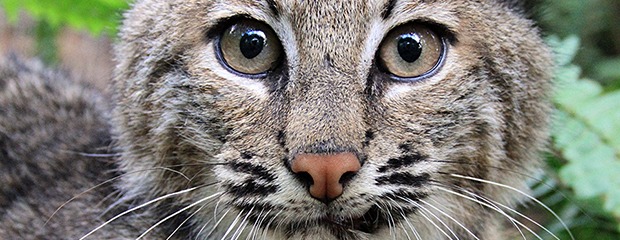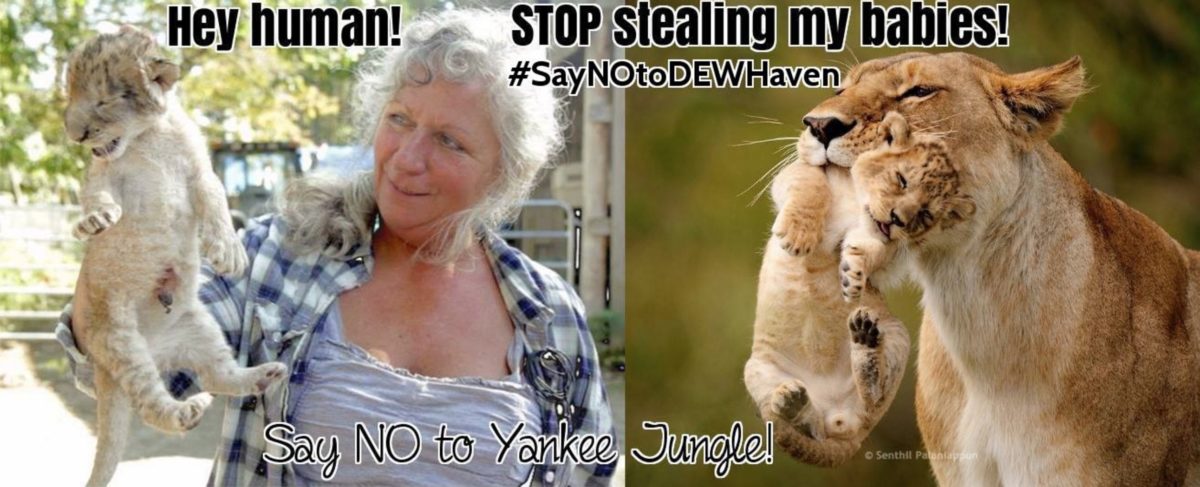Blood Lions
Blood Lions
Blood Lions ran on MSNBC last night in our area at 10pm, which is after my bedtime, so I taped and watched it this morning. I cried throughout, for the suffering of these lions, but by the end I was weeping. I couldn’t even speak without crying uncontrollably. Howie had taken Jamie and Justin to the airport at 5:30 am for their trip to be honored at the Snow Leopard Trust’s celebration event, so he came in to the last 10 minutes of the film. He held me, not knowing what to say, and I was crying so hard that I had a hard time letting him know why I was so emotional.
Of course I was crying over the brutal way big cats are bred constantly, only to have their cubs ripped away at a few days of age, to be passed around as playthings to ignorant patrons, and then warehoused in abysmal conditions until it is their turn to be trotted out in front of an evil excuse for a human, to be used as a living target. That would make anyone with a soul cry.
The weeping however was the kind of emotional release that you see in a nation that comes to the end of a long and bloody war. It is the combination of grieving for those who’s lives were lost, for those who’s lives will be forever impaired and the relief that the suffering is winding down. I wept with pride for all of our staunch supporters who have spoken up for the many city, county, state and federal bills that have passed to protect wild cats in the past 20 years.

When Howie first came to help the sanctuary in 2003 he began working on ways for Big Cat Rescue to become financially self sustaining so that I, and later he, could work on the issues that will end the abuse. This was the first year the sanctuary broke even, which meant I could divert some of the time I spent growing our real estate business to support the cats, into ending the abuse at its root.
In 2003 the root cause of so much abuse appeared to be breeding cubs to be used in canned hunts. I’d seen such a situation in Texas 6 or 7 years prior, where a legal hunting ranch for discarded zoo hoof stock, also had rows of cages of big cats. The cages were tiny jail cells where the cats paced and frothed at the mouth. I asked the owner why he had them and he gave me a sinister smile and said, “They are my pets.” Back in the 90’s I’d never heard the term “canned hunt” and was only just learning that people all over the country kept big cats in back yard cages. I didn’t like what was being done to the zoo hoof stock, but had my own worries in making sure we had eliminated the use of wild cats on fur farms in the United States.
Feeling pretty sure that no bobcats or lynx were being bred on U.S. fur farms any more by 2003, I directed my attention to ending the use of exotic cats in the canned hunting industry. Over the years I’d had people tell me similar stories to mine; where they or their husbands had been to a legal game farm, but had seen big cats in tiny cages too. Some even were reported to have tags in their ears for easy identification by the proprietors and the “hunters” who would pick the cat they wanted to shoot in a fenced area or a cage. Not knowing quite where to start, business people tend to do what they know. In our case, Howie and I turned to the Chamber of Commerce.
They directed us to the National Chamber, who directed us to state agencies and state legislators, who directed us to congressional leaders. Not only did NO ONE want to talk about this, but worse they insisted it wasn’t their problem, but rather was that of the people higher up the food chain. We’ve spent 12 years going up and down that chain, and bringing in everyone we could think of who might have influence. It’s been a grueling and frustrating experience and has been made nearly unbearable due to the apathy of most people who could do something about it, if they cared. They have time to fret and fuss over each other’s party issues, but can’t spend 10 minutes to hear about something they could fix that would end so much misery and help protect our natural resources.
 A turning point came when Cecil the lion was killed by a dentist from the U.S. on a hunting safari in South Africa. When people learned that this easy going lion, who everyone knew by name, had been baited out of a protected area to be shot on private land, THEY CARED.
A turning point came when Cecil the lion was killed by a dentist from the U.S. on a hunting safari in South Africa. When people learned that this easy going lion, who everyone knew by name, had been baited out of a protected area to be shot on private land, THEY CARED.
Within weeks, a documentary called Blood Lions, aired. (It had been in the works since 1998)
When I saw it today I was sure that anyone, with any sense of justice, who sees it will care. I can see the light at the end of the dark and dreary tunnel. I believe people will be outraged that our political representatives have allowed this to continue to this day, not only in foreign countries, but on our own soil. The most pertinent question the film makers kept asking is, “Where are all of these cubs going?”
Here in the U.S., most notably in Florida and Texas, canned hunting ranches abound. There is no excuse for that sort of cruelty, but the mere presence of big cats on those properties should be clear evidence that illegal hunting is happening there too. The more easily exposed abuse is that of cubs being bred for pay to play schemes. There is no legitimate place for those cubs to go as soon as they are 12 weeks old, and have teeth and jaw strength capable of biting to the bone. The people who use them for photo ops, swimming with the tigers and pay to play booths, always insist that the older cubs go to wonderful sanctuaries in the end, but there are only a handful of wonderful sanctuaries, and they don’t accept cast offs where the owners continue to breed and discard, so WHERE ARE ALL THOSE CUBS GOING?
In Blood Lions they discovered that all of the places in Africa, that say they send their cubs back to the wild, or to sanctuaries or non kill parks, were lying. Is it any stretch of the imagination to think that people who are heartless enough to breed lions, tigers and ligers, only to pimp them out, would discard them to any place that would take them; regardless of how horrific that end use might be? The breeders and dealers are the only ones proclaiming, even more loudly than our government, that where these big cats end up, isn’t their problem. I think our politicians and our federal and state agencies are about to find out that people DO care and they will be expected to turn their backs on the donations and kickbacks offered by those who kill and exploit wild animals for fun and profit.
Perhaps, one of the biggest forms of relief came from the exposure of the fact that NONE of the places that allow a person to have contact with an exotic cat, or their cubs, are part of the solution and rather that they are ALL part of the problem. So many young men and women have been duped into supporting these canned hunts, by bottle feeding baby lions, tigers and ligers or by keeping them accustomed to people, so that they are later easy targets. No one who really loves animals would ever be a part of these schemes. I believe Blood Lions will drastically reduce the income generated by the public paying to have such experiences and will eliminate the free labor. Would I be asking too much to hope that all of those people, who are now educated by Blood Lions, will become outspoken advocates to end the entire canned hunting industry?
We can end it in our country. We can’t be taken seriously by other countries until we clean up our own mess. We can start by ending the private possession of wild cats. There is a bill before Congress right now that will do that. Ask your member of Congress to champion the Big Cat Public Safety Act (the bill is HR 3546 if you want to sound cool) We make it easy at BigCatAct.com
Here is a great way to spread the word, in a fun way, about how abusive cub handling is. Check out TigerSelfieApp.com





